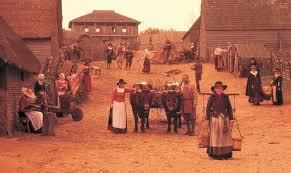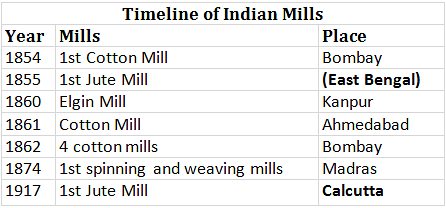Key Concepts: The Age of Industrialisation | Social Studies (SST) Class 10 PDF Download
| Table of contents |

|
| Before the Industrial Revolution |

|
| Hand Labour and Steam Power |

|
| Industrialisation in the Colonies |

|
| Factories Come Up |

|
| The Peculiarities of Industrial Growth |

|
| Market For Goods |

|
| Conclusion |

|
Before the Industrial Revolution
- Proto-industrialisation was the stage when large scale industrial production took place in the absence of modern factories for the international market.
- The acquisition of colonies and expansion of trade in the 16th and 17th centuries led to greater demands for goods.
- Trade guilds, associations of producers, trained craftsmen and artisans. They restricted the entry of new people into the trade.
- A close relationship between town and countryside developed between farmers and merchants.
The Coming Up of the Factory
- Factories emerged in England in the 1730s. Changes brought about in the production process because of inventions in the 18th century.
Example: Cotton mill by Richard Arkwright. - The cotton and metal industry (iron and steel) grew rapidly from 2.5 million pounds import of raw cotton in 1760 to 22 million pounds in 1787. By 1873 iron and steel exports rose to 77 million pounds.
- Small and ordinary inventions contributed to many merchandised sectors like food processing, building, pottery, glasswork, tanning.
The Pace of Industrial Change
Traditional vs. New Industries: Traditional industries persisted, with less than 20% of the workforce in advanced sectors by the end of the 19th century. Many textiles were produced domestically rather than in factories.
Slow Technological Adoption: Technological changes were gradual and expensive. New technologies, like improved steam engines, were slow to be adopted and often faced issues with effectiveness and maintenance. By the early 19th century, steam engines were rare, with most used in cotton and other industries only later in the century.
Worker Profile: By the mid-19th century, most workers were traditional craftspersons and laborers rather than machine operators.
 Life of People before Industrial Revolution
Life of People before Industrial Revolution
Hand Labour and Steam Power
Machines played the following role in the 19th century:
- They required large capital investment.
- The wear and tear of machines made investors cautious and wary of dependence on them.
- Seasonal industries related to gas work, breweries, ship repair, bookbinders also did not depend on machines.
- Machines could produce only a limited variety of products like uniforms or products meant for mass production.
Life of Workers
- There was no labour shortage. Wages were low.
- Human labour was more dependable and cheaper in those days.
- Hand labour could be easily employed seasonally.
- Handmade goods were more in demand among the rich and upper classes as a symbol of class and refinement.
- The conflict between technology and tradition led to the hostility of workers, machines became a target as they caused unemployment, especially among women workers.
- The invention of Spinning Jenny by James Hargreaves in 1764 reduced labour demand.
- Life improved after the 1840s due to massive building activities involving road construction, railways, tunnels, sewers. The number of labour doubled in the transport industry.
Industrialisation in the Colonies
- India started industrialisation under British rule.
- Pre-colonial industrialisation was slow. Silk and cotton textiles were traditional items of export.
- Exported as far as Afghanistan, Persia, Central Asia, South-East Asia from Surat in Gujarat, Masaulipatnam on Coromandel coast and Hooghly in Bengal.
- A number of merchants and bankers involved in the network of import and export.
- Europeans wrested monopoly of trade in the mid-18th century through concessions from rulers, monopoly rights etc.
 Life after Industrial Revolution
Life after Industrial Revolution
- Old ports like Surat were replaced by new ports in Calcutta, Bombay and Madras.
- The textile industry changed dramatically after the conquest of Bengal and Carnatic in the 1760s and 1770s.
- Weavers suffered the most. Forced to work for the company, which acted through their agents called Gomasthas.
- After the 1770s, the English controlled trade, eliminated competition, prevented the weavers from dealing with other buyers. They were severely punished for delays.
- There was desertion and migration by farmers of Carnatic and Bengal weavers.
- Manchester came to India in the form of cotton textiles produced in English factories.
- Imposition of import duties on Indian cotton and the sale of British goods in Indian markets at cheaper rates led to a decline in Indian exports of cotton piece goods.
- Exports fell from 33% in 1811-12 to 3% in 1850-51, whereas imports increased from 31% in 1850-51 to 50% in 1870.
- When Indian factories started producing cotton textiles, it spelt doom for Indian weavers. They were already reeling under the price rise in the supply of raw cotton due to the American War of Independence.

Factories Come Up
- Industries were set up by different groups in different places. Most of the entrepreneurs began as investors in trade with China, Burma, Middle East and East Africa.
- Prominent entrepreneurs were:
(i) Bengal: Dwarkanath Tagore
(ii) Bombay: Dinshaw Petit and Jamshedji Nusserwanjee Tata
(iii) Calcutta: Seth Hukam Chand
(iv) Father and grandfather of G. D. Birla
- Europeans controlled a large section of Indian industries like the Bird Heiglers & Co., Andrew Yule and Jardine Skinner Co.
- Factory workers increased from 5,84,000 in 1901 to 24,36,000 in 1946.
Where Did the Workers Come From?
- Workers came from the neighbouring district of Ratnagiri to work in the cotton industry. Peasants and artisans from Kanpur district came to work in Kanpur Mills and migrant workers from UP to work in Bombay textile mills or jute mills of Calcutta.
- Jobbers became a new group of workers who got villagers to work in cities. They gained importance through commissions and services like housing, rent etc.
The Peculiarities of Industrial Growth
- Industrial production in India was dominated by European managing agencies. They produced items of export and not for sale in India: Tea, Coffee, Indigo, Jute and Mining.
- To avoid competition with Manchester products, India produced coarse yarn (thread) in the late 19th century. Swadeshi activists, during the national movement, mobilised people against the use of foreign goods.
- The First World War led Britain to produce materials for war. Indian factories started producing and supplying war goods, such as jute bags, uniforms, leather boots, horse and mule saddles.
- After the war, the British lost their economic predominance. New technologies developed in Germany and Japan took the lead.
- Small-scale industries predominated in India between 1900–1940. Only a small proportion of the total industrial labour force worked in registered factories. The rest worked in small workshops and household units. Handicrafts production expanded in the twentieth century. In the twentieth century, handloom cloth production expanded. It happened because of technological changes as they started adopting new technology which helped them improve production without excessively pushing up costs.
- Large industries were located in Calcutta and Bombay. In 1911, 67% of them were in these two cities.
Market For Goods
- A significant feature of the 19th-century Indian economy was the attempt to dominate it by foreign manufacturers.
- Indian weavers, craftsmen, traders and industries made collective demand for tariff protection, grants or concessions.
- Advertisements became popular as an attempt to increase sales and win the consumer’s confidence.
- Manchester industrialists used their labels on clothes sold in India — “Made in Manchester” was written in bold letters.
- Indians used images of Gods and Goddesses, Emperors and Nawabs on calendars to boost sales.
- During the nationalist struggle and Swadeshi movement, Indians used advertisements very effectively in papers, journals and magazines.
Conclusion
The age of industries has meant major technological changes, the growth of factories, and the making of a new industrial labour force. Hand technology and small-scale production remained an important part of the industrial landscape.
|
63 videos|445 docs|87 tests
|
FAQs on Key Concepts: The Age of Industrialisation - Social Studies (SST) Class 10
| 1. What were the main differences between hand labour and steam power before the Industrial Revolution? |  |
| 2. How did industrialisation in the colonies differ from that in Europe? |  |
| 3. What role did factories play in the industrialisation process? |  |
| 4. What were some peculiarities of industrial growth during this period? |  |
| 5. How did the market for goods evolve during the Age of Industrialisation? |  |

|
Explore Courses for Class 10 exam
|

|



















